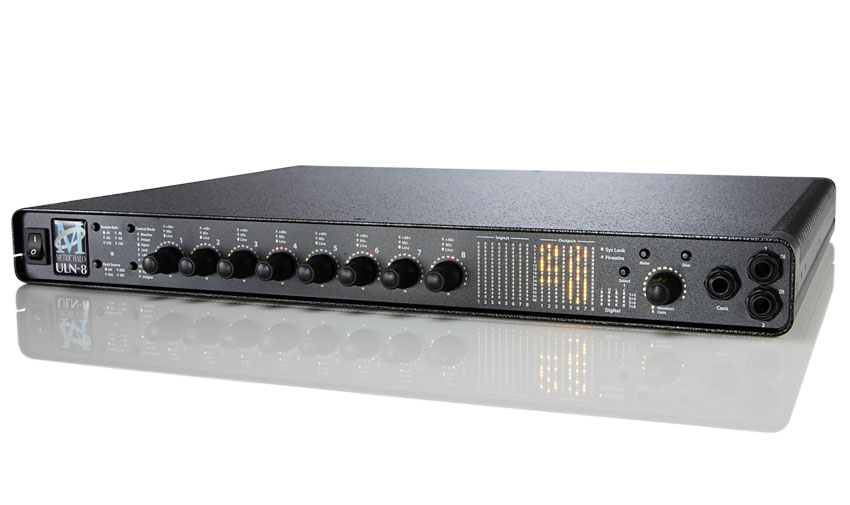MusicRadar Verdict
It's pretty much the closest thing we have seen to a complete studio in a box. Excellent.
Pros
- +
Excellent sounding convertors. Onboard DSP with great compression, EQ and enhancement tools. Stereo to 7.1 monitor controller.
Cons
- -
Not many, providing you can afford it...
MusicRadar's got your back

Metric Halo ULN-8

Rear
For a 1U rackmount unit the ULN-8 is about as fully featured as you can imagine for an eight channel interface.
The front panel sports an enormous array of controls and metering and consequently some of the switches are pretty small and the legends are little, but somehow Metric Halo have managed to make it all look professional and accessible.
The unit itself is only half of the story, however, as what you also get is a software controller called MIO Console which allows you to control and store all your front panel settings plus do a whole lot more.
Full of features
"Each mic input has plenty of gain so even the lowest of signals will cause no problem"
The unit itself sports eight analogue inputs which can be switched between line and mic. Each mic input has individually switchable phantom power and plenty of gain so even the lowest of signals will cause no problem.
To the right is a monitor knob that can be switched between monitor and headphone control and there is a headphone out on the front panel. The headphone control and there is a headphone out on the front panel. The front panel also sports two DI inputs which can be assigned to any of the eight input channels.
The majority of the audio connections on the rear are 25-pin D-subs (Tascam protocol) and you get line in/out, mic ins and balanced sends. Outputs 1 and 2 are also available on balanced (TRS) 1/4-inch jacks and there is one more D-sub giving eight in and out AES digital connections. There is also wordclock in and out (BNC) and timecode in and out on 1/4-inch jacks.
Software controller
MIO console is a highly flexible software mixer that sits between the interface and your DAW and allows you to configure the system to pretty much any purpose you can imagine. Each individual channel has a control section allowing you to set inputs and gains.
In addition you can then give each input a 'character' using one of the onboard plugs powered by the onboard DSP. There are a few to choose from but the transformer and valve options are extremely good. Then you can add plugs on the insert points to compress, EQ, add delays, reverbs and some very usable soft clip functions too. The advantage here is that you can set up a finished sound before it even hits the DAW.
As the mixer also allows you extremely low latency monitoring, even with a slew of plugs running, any latency issues you may have with monitoring through your DAW become irrelevant. Whole set-ups can be stored and recalled so getting the sound back when you change your mind about a bass part a month after recording it is a breeze, and those Metric Halo plugs do sound great.
Top sounds
"As to the quality of the convertors and mic pres - they are excellent"
As to the quality of the convertors and mic pres they are excellent. Well up there with the best of what is available. The fact that it's FireWire also means that with all that functionality your laptop can be a fully functioning studio just with a ULN-8, a pair of monitors and some cans.
For a project studio you can have all your analogue synths, a guitar and a bass DI, and eight mic inputs permanently plumbed in, each ready to be recorded through your favourite chain of processing. If you have a few favourite analogue processors it will allow you to use them as inserts and any digital toys with AES ins and outs can be brought into the mix too.
You can even use it as a summing mixer using those character plugs to add some extra colour to your mix. Monitoring is simple and latency free and, although it's not the cheapest interface on the market, when you consider what you are getting for your money, and especially with that recent price drop, it can only be considered a bargain.

“It’s kind of scary to go through these…like, ‘Oh I’m going to take that back!’”: Albert Hammond Jr of the Strokes is (reluctantly) selling a heap of his stage-played gear on Reverb, including a Guild acoustic from the Yours To Keep tour

“There’s three of us playing guitar in Foo Fighters… A lot of tone details can get lost, which is what drew me to the Cleaver – that P-90 cut”: Chris Shiflett on how he found his weapon of choice with his Fender Cleaver Telecaster Deluxe

“People have used it as their wedding song. I often think, ‘Hey, did you listen to the lyrics?’”: The classic number one hit with a sting in its tail
Most Popular







